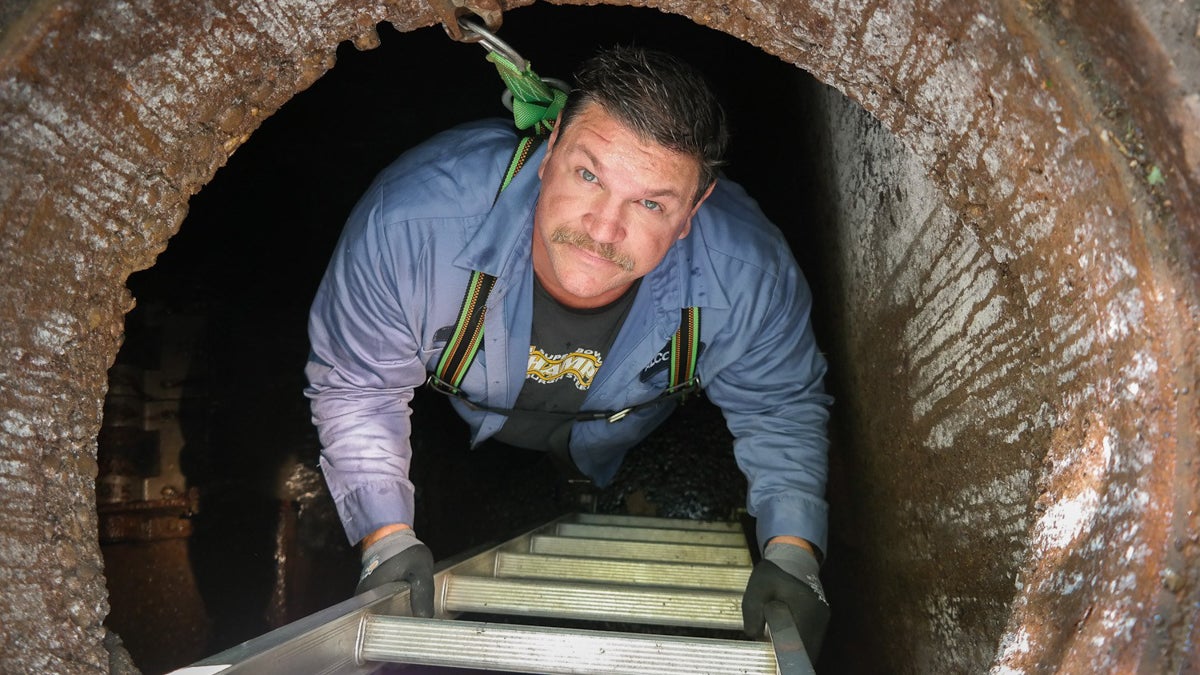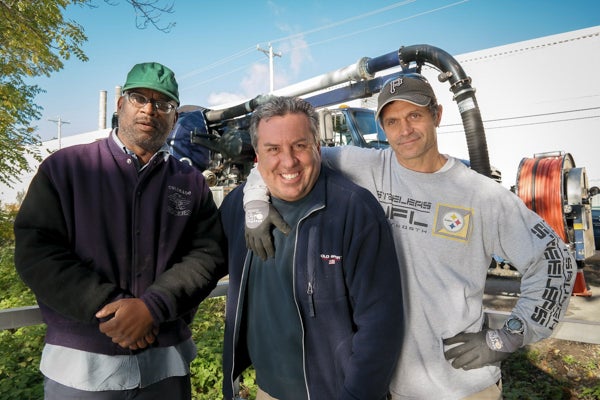The dirty lives of Pittsburgh’s sewer cleanup crew
Listen
Donny Smith descends into one of the Pittsburgh sewer authority's "combined sewer overflow" structures. (Lou Blouin/for WHYY)
During heavy storms, the city’s backup sewer system dumps raw sewage into local rivers to prevent basement floods and sludge in the streets.
Damon “Hop” Hopkins only needs two words to tell you about the grossest thing that’s ever happened to him working in Pittsburgh’s sewers. That—and a lengthy, well-timed pause between words two and three.
“Chest-high. Feces.”
‘Nuff said.
Hopkins works on a maintenance crew for ALCOSAN, the sewer authority in Allegheny County, Pennsylvania. He and his co-workers have lots of war stories. Supervisor Charles Simone’s best/worst is the time he was working down in the hole, tugging and pulling at a stuck control gate festooned with trapped tampons, condoms and drowned-rat carcasses. Simone gave a final pull, the gate suddenly broke free, and he was rewarded with a “condom right in the face.”
Ask Darryl Smith for his worst story, and he simply shakes his head, searching for the right euphemisms. He finally says it was one of those foul moments when he was in the “mud,” mud that isn’t really mud. The mud that, based on its stench, is clearly something else.
Ask this crew of men and women about the smell that’s a constant backdrop to their workday and some just tell you: “It smells like money.”
Crew supervisor Mike Altimore calls their existence a “necessary evil.”
“I save the world,” one worker said. “If it wasn’t for me, this whole county would be flooded in piss and shit.”

Darryl Smith, Charles Simone and ALCOSAN crew supervisor Mike Altimore. (Lou Blouin/for WHYY)
You don’t have to look very far back in history to find a time when everything Pittsburghers flushed down their toilets went directly into the rivers. In the 1950s, the city finally built a system of riverside “intercept” structures to divert the raw sewage into deep tunnels, which fed everything back to a wastewater treatment plant. But crews have to constantly keep an eye on these structures, which can clog or jam, causing untreated sewage to overflow into the river.
During big storms, the system is engineered to actually encourage overflows. In Pittsburgh, stormwater and sewer water share a single system. So in heavy rains, waters rushing in from street-level storm drains mix with sewage and quickly overwhelm the system—triggering the gates at the intercept structures to open and release the excess into the rivers. That’s also a necessary evil of the system—the alternative to which is raw sewage backing up into homes and onto streets. The system is designed, so only those who signed up for the job have to muck around in the mud that lies beneath urban life.
Pittsburgh’s sewers are more than 60 years old and considered antiquated. Still, crew supervisor Charles Simone says they’re a marvel. The entire system, which collects wastewater from more than 80 communities, is almost entirely propelled by gravity.
“These guys designed all this with just basic surveying tools. No GPS, no computers, no nothing,” Simone said.
Still, the federal government is now requiring ALCOSAN to modernize the system in order to minimize overflow events that dump raw sewage in the waters of Pittsburgh’s Three Rivers: the Monongahela, the Allegheny River and the Ohio.
For now, the system hovers between its past and future. The Three Rivers are still needed as a last line of defense.
Six-foot-four, 200-and-some pound Don Smith is willing.
He disappears into a manhole that’s just barely wide enough to accommodate his shoulders. Before he slides into the darkness to do some preventative maintenance, he calls for somebody to hold his wallet. “If you fall in, you might save the twenties,” his safety spotter explains. “But you won’t want to bother with the ones and fives.”
WHYY is your source for fact-based, in-depth journalism and information. As a nonprofit organization, we rely on financial support from readers like you. Please give today.



